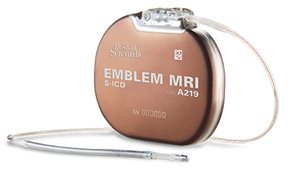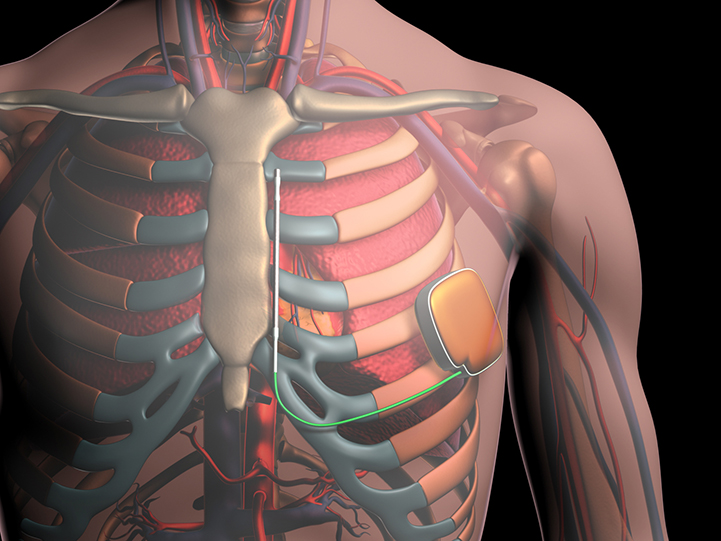An implantable cardioverter defibrillator (ICD) is a small device that’s placed in the chest to treat arrhythmias (irregular heart rhythms). It uses electrical pulses to help control fast, life-threatening arrhythmias in the ventricles (the heart’s lower chambers).
If an ICD detects an irregular heart rhythm, it will use low-energy electrical pulses to restore your rhythm. If that fails, it will provide an electric shock to bring your heart rhythm back to normal. Some ICDs also work as pacemakers, which treat slow heart rates.
At Valley, our electrophysiologists specialize in using the latest ICDs for arrhythmias. If you would benefit from an ICD, our experienced team will help you choose the best option.
Am I a Candidate for an Implantable Cardioverter Defibrillator (ICD)?
An ICD may be right for you if you have one of the following:
- Ventricular tachycardia, a very fast heartbeat that starts in the heart’s lower chambers
- Ventricular fibrillation, a fast, unpredictable heartbeat that causes the heart’s lower chambers to quiver
- Disease of the heart muscle (cardiomyopathy) or heart failure
Benefits of an ICD
If you have any of these conditions, an ICD can reduce your risk for sudden cardiac death.
An ICD can also help reduce arrhythmia symptoms such as:
- Fainting (syncope)
- Fatigue
- Shortness of breath
- Dizziness
- Pounding in your chest (palpitations)
Our electrophysiologists are experts in using ICDs to help reduce your symptoms and serious health risks. We’re here to help if you are considering an ICD to manage an irregular heart rhythm.
Types of ICDs
Valley offers several types and sizes of ICDs. Your electrophysiologist will work with you to determine which type of ICD is best for you.
Transvenous ICDs
Transvenous ICDs have been used for more than 50 years. These ICDs can also work as pacemakers if your heart rate gets too slow.
Transvenous ICDs are implanted under the collarbone in the left part of your chest. They can have one, two or three wires threaded through the veins into the heart.
Subcutaneous ICDs
Subcutaneous ICDs are newer than transvenous ICDs. These devices only act as defibrillators (to shock the heart), not as pacemakers.
Subcutaneous ICDs do not require wiring inside the veins or heart like transvenous ICDs. Instead, the leads are placed outside of your ribcage but under your skin. The ICD itself is placed in your underarm.


CRT-D (Cardiac Resynchronization Therapy Defibrillator)
This device is designed to treat patients with heart failure. It combines the functions of a pacemaker and an implantable cardioverter-defibrillator (ICD) to improve heart function and manage life-threatening arrhythmias. A CRT-D helps resynchronize the heart’s contraction, which can enhance the heart’s pumping efficiency and reduce symptoms of heart failure. This therapy is particularly beneficial for patients who may be at risk of sudden cardiac death.
Heart failure devices, such as Barostim™ or Cardiac Contractility Modulation (CCM), are managed by Valley’s Center for Comprehensive Heart Failure Care.
What to Expect Before Your ICD Procedure
Here’s what you can expect before your ICD procedure:
- Do not eat or drink anything after midnight the day before the procedure.
- Your electrophysiologist may ask you to stop taking your blood thinner 24 to 48 hours before your procedure. Do not stop any medicines unless they tell you to do so.
What to Expect During Your ICD Procedure
The procedure is different if you are having a transvenous ICD or a subcutaneous ICD.
If You Get a Transvenous ICD
Here’s what you can expect if you are getting a transvenous ICD:
- Ask someone to drive you to and from the hospital on the day of your procedure. You’ll need someone to drive you home after the procedure.
- At Valley, a nurse will start an intravenous (IV) line with an antibiotic to prevent infection.
- A nurse will shave and clean one side of your chest.
- Your team will include your electrophysiologist, interventional cardiologist, anesthesiologist and other experts.
- Your anesthesiologist will give you local anesthesia to numb the area of the incisions. They will also give you medicine through the IV to help you relax and sleep.
- Your electrophysiologist or interventional cardiologist will make a small incision below your collarbone to reach a vein leading to your heart.
- They will thread one or more flexible wires (leads) through that vein into the heart using X-ray guidance.
- They will attach one end of each wire in your heart. They will attach the other end to the device, which they’ll usually implanted under the skin beneath your collarbone.
- The surgery usually takes one to three hours.
If You Get a Subcutaneous ICD
Here’s what you can expect if you are getting a subcutaneous ICD:
- At Valley, a nurse will start an intravenous (IV) line with an antibiotic to prevent infection.
- A nurse will shave and clean one side of your chest.
- Your team will include your electrophysiologist, interventional cardiologist, anesthesiologist and other experts.
- Your anesthesiologist will give you local anesthesia to numb the area of the incisions. They will also give you medicine through the IV to help you relax and sleep.
- Your electrophysiologist or interventional cardiologist will make a small incision on the side of chest. They will make a second incision close your breastbone, underneath your left breast.
- They will place both the device and the wire under the skin outside of your chest cavity.
- The surgery usually takes one to three hours.
Recovery After Your ICD Procedure
Here’s what you can expect immediately after your ICD procedure:
- You’ll usually stay in the hospital overnight and go home the following day.
- Before you go home, your doctor will program your device to fit your specific needs.
Here’s what to expect when you go home:
- You may be sore where your ICD was implanted. Over-the-counter acetaminophen and ice can help ease pain.
- Avoid taking aspirin or non-steroidal anti-inflammatory drugs (NSAIDs) like ibuprofen or diclofenac. These can cause bleeding.
- Your electrophysiologist may recommend that you avoid bathing and driving for a week after your procedure.
- Your electrophysiologist may recommend avoiding heavy lifting and vigorous exercise for about a month. They may also suggest not lifting your arm above your shoulder for a month.
- You’ll return to your electrophysiologist’s office in seven to 10 days so the team can check on you and the ICD.
- After that, most ICDs can be checked remotely using wireless technology. Your ICD will send information on your heart rhythm to our office remotely. This saves you from making trips to the office.
Call your electrophysiologist if you have:
- Bleeding
- Discharge (pus) or swelling near the incision
- Chest pain
- Shortness of breath
- Dizziness
- Fainting or near-fainting
- Fever
- Chills
Lead Extraction for an ICD
If you have a transvenous ICD, you have leads (wires) inside your heart that are connected to your device. In some cases, you may need to have the leads removed at some point due to damage or infection.
At Valley, our electrophysiology team is highly skilled at performing lead extractions. They can also replace the old leads with new leads so you can continue your treatment.
Why Choose Valley for an ICD?
- Expertise in advanced ICD techniques: Our electrophysiologists use innovative techniques with ICDs that are not available at many centers. These techniques involve placing the wires in different locations of the heart to get its contractions in sync. Patients who have ICDs placed with these techniques often feel better and have better outcomes.
- Remote monitoring by experts: Wherever you are, your team at Valley can monitor the data sent wirelessly from your ICD. This helps keep your heart rhythm under control and allows you to avoid unnecessary doctor visits.
- Collaborative care team: Our electrophysiologists work alongside interventional cardiologists at Valley during your ICD procedure. Together, they have implanted thousands of devices to help patients live longer and reduce their symptoms of irregular heart rhythms.
- Expertise in all types of arrhythmias: Valley’s Snyder Center for Comprehensive Atrial Fibrillation offers the most innovative ways to treat a wide range of arrhythmias. Our team includes national leaders in electrophysiology who research ICDs and other treatments for patients like you.

